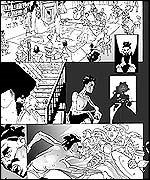
And one more article appears about Siku and Strickson's Wuthering Heights graphical novel (
check the posts if you want to see full screen samples). The
Bradford and West Yorkshire BBC publishes a very interesting interview with Adam Strickson. We only highlight some points because it's a long interview (you can read it complete
here):
Adam, asked how he feels about 'adapting' this world-famous and much-loved novel, stresses while he may have reduced 288 pages to around 50, he has not rewritten the novel: "I've concentrated on the drive of the story which is what I think you have to do in a graphic novel. It's quite a complicated theme. There's a couple of things which I've tried to move along more quickly. There's a few splats and whacks in it as there are in the original novel. There's quite an undercurrent of sex and overcurrent of violence. I guess Emily Brontë's world in Haworth was mean and violent in many ways. The Brontës were living in a time of widespread death and poverty and they couldn't escape that in the Parsonage." (...)
"But Wuthering Heights is not fun. What I've done, and what Siku has done more then me, is to make it immediately accessible to young people. It is a convoluted story with many, many changes of situations and generations and I think it's quite difficult when you first read it. Hopefully it will bring some people to the novel and hopefully people who already know it will enjoy the graphic novel for what it is which is essentially bringing it to life in images. It's not a substitute at all for reading the book. It's still 50 pages of a graphic novel and perhaps people who read those will also come to Wuthering Heights. You could see it in a way as a film treatment - it's a series of visual images with words but words are not the primary thing in the graphic novel. I was brought into the project essentially as a script writer and the process is the same. You are writing a series of action frames which is what the graphic novel is." (...)
It's not a substitute at all for reading the book. It's still 50 pages of a graphic novel and perhaps people who read those will also come to Wuthering Heights. You could see it in a way as a film treatment - it's a series of visual images with words but words are not the primary thing in the graphic novel. I was brought into the project essentially as a script writer and the process is the same. You are writing a series of action frames which is what the graphic novel is." (...)
Has the idea of Heathcliff as an outsider influenced his approach to the novel? Adam believes he and Siku have presented their readers with a Heathcliff and Cathy for our time: "When Heathcliff arrives at the house he's referred to as being dark. In the book he's called a gypsy brat by the other children and servants. The way he's been drawn by Siku it's fairly obvious he does look different to the other characters. Cathy in the graphic novel is not perhaps the way we imagine her from Emily's book. She is slightly older, slightly more sexy and I guess she hasn't been starved in a way a young person living at Wuthering Heights would have been at the time Emily was writing."
In the novel Heathcliff is described as a Lascar [a name used for Asian seamen at the time of the Brontës]. Adam says: "Emily would have known gypsies and might have come across Lascars on her few visits out and, as we know, she was very widely read but it all comes from the incredible imagination she had. That's what still holds up because so few writers have the power to imagine such a world from the resources they have in their head." (...)
Categories: In_the_News, Wuthering_Heights, Comics










0 comments:
Post a Comment